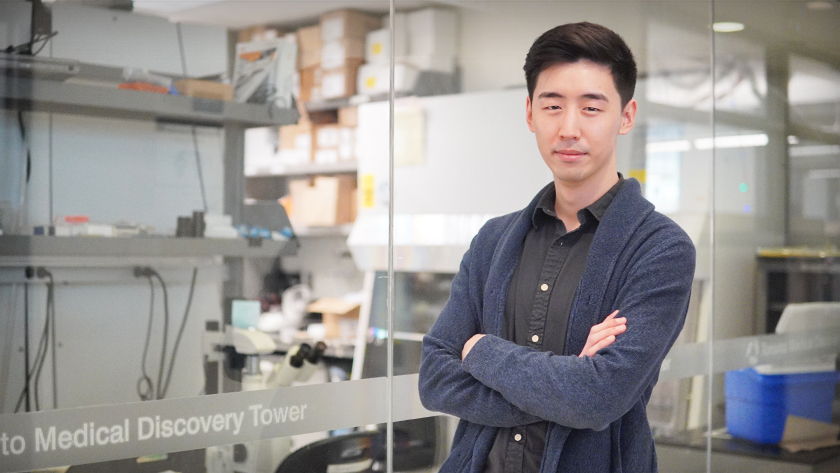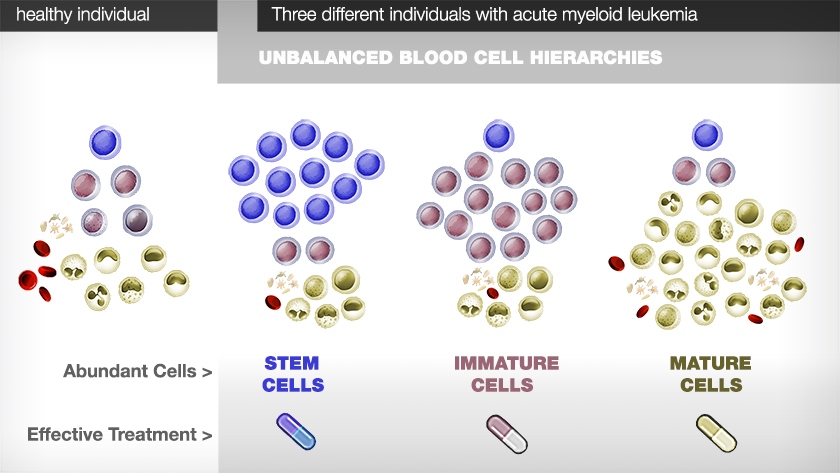
A study published in Nature Medicine from researchers at the Princess Margaret Cancer Centre reveals a potential way to tailor acute myeloid leukemia (AML) therapies to individual patients.
Currently chemotherapy remains the main treatment for individuals with AML. Despite this one-size-fits-all approach, cancer cells in AML are
not all the same. An important insight is that cancer cells can be categorized within the hierarchy of normal blood development. The distinct types of cancer cells found in AML—and specifically their proportions within the hierarchy of blood development—differ between individual patients. Because of this, patients respond differently to therapy.
While there has been an emergence of new AML therapies into the clinic that target different cancer cell vulnerabilities, it is still difficult to predict which therapy would be best suited for each patient.
To address this, a team of researchers led by Senior Scientist Dr. John Dick developed an approach that can help predict a cancer’s response to therapy in a biologically intuitive way.
“In our approach, we considered the identity of all the leukemic cells present in a particular patient and asked how each type of leukemia cell compares to a normal blood hierarchy. In this way, we created a description of each patient’s cellular hierarchy,” says Andy Zeng, an MD/PhD candidate in Dr. Dick’s lab and first author of the study. “This personalized description of the leukemic hierarchy, which comprises different cancer cells that are present in different proportions, represents a type of ‘fingerprint’ that we can use to compare to any clinical property including how an individual’s cancer will respond to therapy.”
In the study, the team characterized the personalized cellular hierarchies of more than 1000 AML patient samples using genomic sequencing data from leukemic cell types that ranged from stem cells to mature cells. Gene expression was used to estimate the abundance of each cell type within a patient’s hierarchy.
They found that these personalized hierarchies could be grouped together, resulting in four main classes, where each class varies in how they respond to experimental drugs. They also identified a panel of seven genes that can be used to classify patient hierarchies and then predict how each particular AML sample will respond to over 100 experimental drugs.
“These new insights address a long-standing clinical challenge in AML—one that has prevented us from predicting survival outcomes and relapse following chemotherapy. By looking at the cell hierarchies in these cancers, we can now identify which drugs can best target them. These insights are now enabling us to explore how therapies can be tailored to individuals, so that the right patient gets the right treatment when they need it the most. We think this approach we developed for AML might be applicable to many other types of cancer” says Dr. Dick.
This work was supported by the Canadian Institutes of Health Research, the Ontario Institute for Cancer Research, the International Development Research Centre, the Canadian Cancer Society, the Terry Fox Research Institute, the University of Toronto’s Medicine by Design, the Government of Ontario and The Princess Margaret Cancer Foundation. Dr. John Dick holds a Tier 1 Canada Research Chair in Stem Cell Biology and is a Professor in the Department of Molecular Genetics at the University of Toronto.
Zeng AGX, Bansal S#, Jin L#, Mitchell A, Chen WC, Abbas HA, Chan-Seng-Yue M, Voisin V, van Galen P, Tierens A, Cheok M, Preudhomme C, Dombret H, Daver N, Futreal PA, Minden MD, Kennedy JA, Wang JCY, Dick JE. A cellular hierarchy framework for understanding heterogeneity and predicting drug response in AML. Nat Med. https://www.nature.com/articles/s41591-022-01819-x. DOI: 10.1038/s41591-022-01819-x. #contributed equally

In normal blood development, a blood stem cell forms a hierarchy of cells from less mature to more mature cells. In leukemia, a leukemia stem cell also gives rise to a hierarchy of cells, and the composition of these cells varies between patients, leading to different drug responses.




